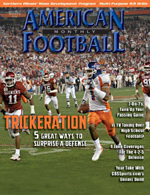Article CategoriesAFM Magazine
|
Packaging The Inside Zone With The Bubble Screen Out of a Stack Formationby: Mike EmendorferHead Coach University of Wisconsin-Platteville © More from this issue In this article, we will discuss our stack formation and cover the basic principles of our inside zone play. We will then explain the quarterback’s and running back’s reads and meshing techniques. In the end we will focus on the bubble screen concept.
| 
|
Subscribe now to start receiving our monthly magazine PLUS get INSTANT unlimited access to over 4000 pages of 100 percent football coaching information, ONLY available at AmericanFootballMonthly.com! | |||
NEED PASSWORD HELP |




